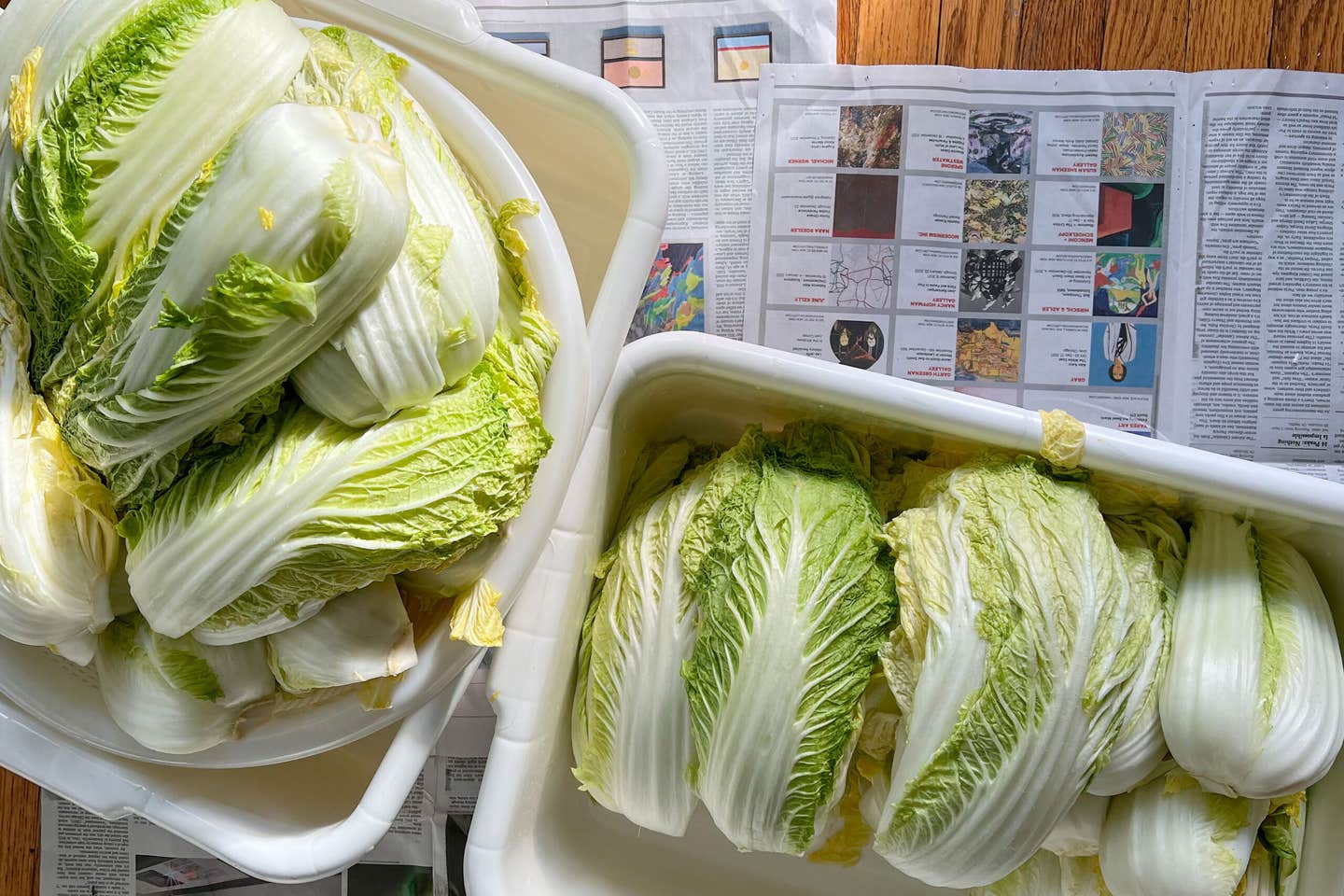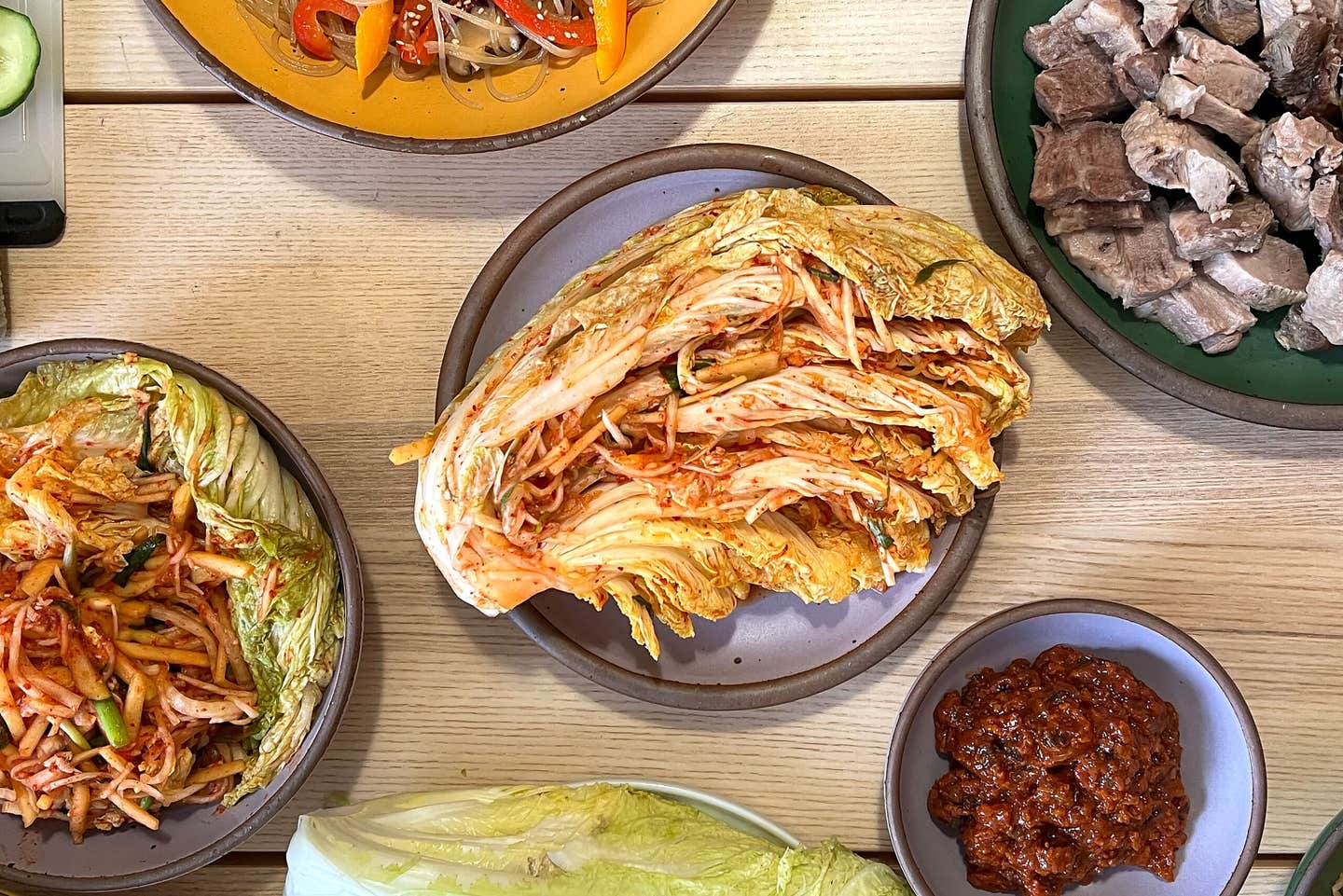
I Made This Classic Korean Dish in My Bathtub
How making kimchi in my tiny studio apartment helped me find my way back to my Korean heritage.
The night before my annual gimjangs, communal kimchi-making gatherings held every autumn in Korean culture, I scrub down my bathtub. Once it’s clean and sanitized, I haul out the giant plastic tubs I keep solely for gimjang, place them in my bathtub, and fill them with cold water. I pour in coarse Korean sea salt and swirl it around until the salt has dissolved, then wash, trim, and quarter heads of baechu (napa cabbage) before stuffing them with salt. I submerge the salted cabbage in the salted water, weigh everything down with metal bowls filled with water, then let the baechu sit overnight. If I lived elsewhere, I might do this in a kitchen, but in my tiny studio apartment in Brooklyn, my bathroom provides me the best access to space and water.
In the morning, my bathroom smells sweet and fresh as I rinse the baechu and arrange the now-tender leaves into a large strainer. Then it’s time to tidy up before my friends start to arrive. I don’t know exactly how nine people are going to fit in my studio or where they’re all going to work, and there definitely won’t be enough chairs when we eat bossam afterwards. Fortunately, it’s gimjang, so the point is to bump elbows and gossip while we chop.
I am a second-generation Korean American born to immigrant Korean parents, but I never made kimchi as a kid. I was born in Flushing, Queens, and grew up in the Los Angeles suburbs just 30 minutes from Koreatown. We had easy access to fresh, high-quality kimchi, which made gimjangs feel like labor-intensive relics of the past.
Then there was this: beginning in high school, I was shamed for my body because I was overweight and my Korean community found my body grotesque. For the next decade, I counted calories, restricted foods, jumped on fad diets and Jenny Craig, and worked out obsessively. I loathed myself because, as everyone from family to friends to random ajummas (middle-aged women) in restaurants never hesitated to let me know, I was disgusting. A Miss Piggy who needed to whittle her body down to acceptable standards if she wanted to be a person of value. Naturally, any love for food and any curiosity about cooking, even Korean cuisine, had to be repressed.
It wasn’t until I moved across the country to Brooklyn in 2012 that I found the physical and mental distance to start healing from that trauma. Far away from LA’s Koreatown, I started teaching myself how to cook Korean food like soups and stews, but remained hesitant to venture into more challenging projects that felt more quintessentially Korean, including making kimchi. Who was I to try to claim that kind of Koreanness for myself, when Koreanness had rejected me for so long? And how could I even learn to make the dish when a big part of gimjang was its communal nature and I had spent the last decade-plus of my life isolating myself out of shame?

In spring 2019, I attended a book club hosted by The Cosmos Book Club and made a new friend. She was Korean American, too, and we quickly learned that we both liked to cook, agreed that ramyeon should always be chased with ice cream, and had never made kimchi before. As gimjang season approached, we decided we should just do it. We invited a few friends—asking everyone to bring their own knife, cutting board, and kimchi containers—cobbled together a recipe, and co-hosted our very first gimjang in my tiny Brooklyn apartment.
Technically, making kimchi is fairly simple, as we learned. After prepping the night before our first gimjang, all we had to do on the day of was to chop our filling (Korean radish, scallions, apple, pear) into uniform lengths, peel a ton of garlic and roughly blitz it in a food processor with ginger, then combine everything with gochugaru, salted shrimp (or fish sauce), and a slurry of anchovy broth and glutinous rice flour. Then, we stuffed the filling between the leaves of our salted cabbage, packed our containers, and poured any remaining liquid over the fresh kimchi. My friends all took their kimchi home and left it out for one to three days to get the fermentation going, during which everyone burped their containers occasionally, before storing it in their fridges to age for as long as we wanted. And just like that, here was the first batch of kimchi I had ever made.
As my friends and I crowded around my dinner table, laughing while we chopped ingredients and peeled a stupid amount of garlic, I was able to find healing. This activity of making kimchi with a group of fellow adults who shared my heritage would have been unfathomable to the lonely, isolated person I once was, afraid of claiming her Koreanness. By choosing to share that vulnerability with others, I found both a community and more confidence in myself.

I thought we’d do one gimjang and move on, my curiosity satiated, but, as I learned, I wasn’t done with kimchi. The challenging part of kimchi-making is what Koreans call sonmaht, literally translating as “hand taste,” which one really only acquires through experience. At that first gimjang, we went for kimchi that was more punchy, leaning heavily on the garlic and salted shrimp because, in retrospect, maybe that felt the most Korean to us. The whole point of this, after all, was gathering friends to learn, together, how to make a food that so deeply represents Koreanness, an identity that often felt fraught for us as Korean Americans. And I liked how our first batches came out. At the same time, though, I wanted to go further, and try to make kimchi that felt more mine, more in line with my own palate and taste.
After that first gimjang in 2019, I began to routinely make tiny batches of kimchi throughout the year, learning my own sonmaht so we could make better kimchi at what I knew would become an annual event I’d host for my friends year after year. Along the way, I learned to balance my flavors better: I bring in additional sweetness by adding more pear and apple (never sugar), and I’ve played with softer, brighter flavors, omitted salted shrimp altogether, and added fish sauce for a more subtle funk.
Now, every year when autumn settles in, I start thinking about our next gimjang. I think about what I’ve learned from my tiny batches and make an ingredient list. I plan our menu for the post-gimjang dinner of bossam, a braised pork belly to wrap in any leftover salted baechu with radish filling. And I think about how this all became possible because of one friend who had her own questions about Koreanness and was willing to go exploring with me, to establish a new tradition. A tradition that has helped anchor me through the ups and downs of healing by creating a soft space where it is okay to question and struggle. I still grapple with body image issues regularly, but making kimchi has at least helped me appreciate what my body can do and learn, no matter how I look. I can learn to taste and, in doing so, figure out my own way of being Korean American.
Keep Reading
Continue to Next Story










